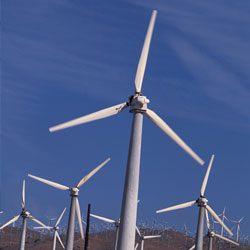 When Maryland issued its request for interest (RFI) for offshore wind leases off its coast last year, terrestrial-based wind developers, such as RES Americas, Iberdrola Renewables and NRG Energy, answered the state's call alongside offshore-only wind developers, such as Fisherman's Energy.
When Maryland issued its request for interest (RFI) for offshore wind leases off its coast last year, terrestrial-based wind developers, such as RES Americas, Iberdrola Renewables and NRG Energy, answered the state's call alongside offshore-only wind developers, such as Fisherman's Energy.
While the Bureau of Ocean Energy Management, Regulation and Enforcement (BOEMRE) is evaluating the merits of the proposals in Maryland, it is likely that more terrestrial wind developers will follow the path of RES Americas and NRG Energy offshore when the agency releases additional RFIs in Atlantic Coast states later this year.
Offshore wind represents a big opportunity for land-based developers, explains David Gaier, spokesperson for NRG Energy, which owns more than 400 MW of installed capacity from four Texas wind farms. The company also owns offshore wind developer Bluewater Wind, which it acquired in November 2009.
‘It's a natural evolution,’ Gaier says. ‘There's an abundance of offshore wind resources along the East Coast located near the population centers,’ he says, adding that with land-based development, the wind resource is often very far or removed from population centers.
Chris Morgan, CEO of RES Offshore, which will collaborate with RES Americas, agrees that offshore wind can play a big role in North America, especially on the East Coast, where demand load is high and there is a significant resource accessible to current technology.
Others explain that it is a matter of clear policy.
‘[Developers] are following the signal set by the White House and the U.S. Department of the Interior that the U.S. is open for business in offshore wind, and they want to be part of it,’ explains Jim Lanard, president of the Offshore Wind Development Coalition.
But where there are opportunities, there are also challenges.
‘Just being an experienced land-based wind developer is no training ground for offshore success,’ explains Lanard.
He says that although the wind turbines may look the same above the water, that's where the similarities end.
‘There are significant differences with logistics, installations and managing the subcable,’ explains Lanard.
In fact, he says, because the disciplines between onshore and offshore development are so stark, even the most battle-tested wind developers are enlisting the help of European firms with offshore wind experience.
For RES Americas, that means enlisting the help of its offshore subsidiary, which according to the company, has more than 6 GW of offshore experience in development, operations and maintenance, and engineering.
‘Working to maximize the full range of opportunities presented by large-scale commercial offshore wind development presents a significant challenge,’ explains Morgan. ‘Many stakeholders must be addressed. We believe that, by combining the skills and expertise of RES Offshore with our existing experience and presence within the North American market, we can make a valuable contribution.’
And as additional areas are identified by the BOEMRE, companies, such as RES Americas will be sure to be a part of the mix.
‘We are continually evaluating new opportunities in this market as we do with onshore wind development,’ Morgan explains.



